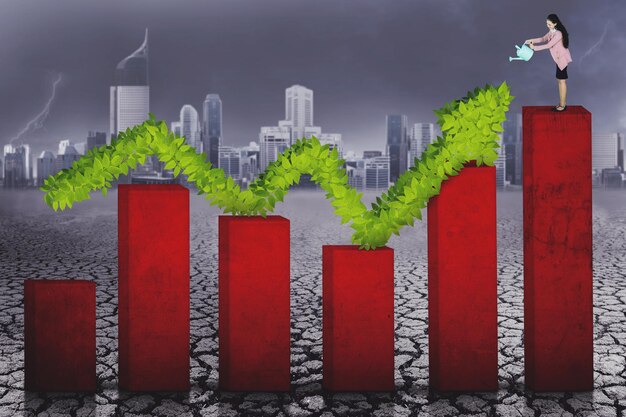Economics is the study of how resources are allocated, how markets function, and how people and businesses make decisions based on available information. Economic trends—patterns in economic activity—are essential for understanding the forces that shape growth and decline in an economy. These trends provide insights into how economies expand, contract, or experience stagnation, and they play a crucial role in determining policies, business strategies, and individual financial decisions.
In this article, we will examine the various economic forces that influence growth and decline, how they are interrelated, and the implications for both businesses and individuals. By understanding these trends, you can better navigate the complexities of the global economy.
The Forces Behind Economic Growth
Economic growth is a sign of an expanding economy, where there is an increase in the production of goods and services, improvement in living standards, and greater job opportunities. Various factors contribute to growth, some of which include:
1. Technological Innovation
One of the primary drivers of economic growth is technological progress. Advances in technology increase productivity, create new industries, and improve efficiency in existing sectors. Innovations such as the internet, automation, and artificial intelligence have revolutionized industries, enabling businesses to scale operations and reduce costs. As technology improves, it opens new markets, creating job opportunities and driving economic expansion.
2. Human Capital Development
Human capital refers to the skills, knowledge, and abilities of a workforce. Investing in education and training enhances human capital and leads to increased productivity and higher wages. When individuals are better educated and trained, they are more capable of adapting to new technologies and industries, driving economic growth. Countries that invest in their workforce tend to experience higher levels of innovation, economic competitiveness, and long-term prosperity.
3. Capital Investment
Capital investment is essential for fostering economic growth. This includes investments in infrastructure, machinery, and technology that improve productivity across various sectors. When businesses and governments invest in physical and human capital, the economy benefits through the creation of jobs, enhanced efficiency, and improved living standards.
4. Trade and Globalization
Global trade is another crucial factor in economic growth. Countries that engage in international trade can specialize in producing goods and services in which they have a comparative advantage, allowing for higher output and lower costs. As global markets become more interconnected, businesses gain access to larger consumer bases, which can lead to increased demand and economic expansion. Globalization also allows the flow of capital, technology, and ideas between countries, promoting growth.
5. Monetary and Fiscal Policy
Government policies, including monetary and fiscal policy, play a significant role in economic growth. Central banks control the money supply and interest rates, which directly affect investment levels, consumption, and inflation. Fiscal policy—government spending and taxation—can stimulate demand through public investments and social programs. By adjusting interest rates or stimulating demand, governments can encourage economic expansion during periods of stagnation or recession.
The Forces Behind Economic Decline
While growth is desirable, economic declines or recessions are inevitable parts of economic cycles. A decline in economic activity can be triggered by several factors, which can have long-lasting effects on businesses and individuals. Some of the primary forces behind economic decline include:
1. Economic Shocks
Unpredictable events such as natural disasters, geopolitical instability, or pandemics can cause sudden disruptions in the economy. The COVID-19 pandemic is an example of how an unexpected global crisis can send economies into a recession. These economic shocks can result in widespread job losses, reduced consumer spending, and decreased investment, leading to a prolonged period of economic decline.
2. High Levels of Debt
Excessive debt—whether private, corporate, or government debt—can trigger economic decline. High levels of debt lead to financial instability and reduce the ability of individuals, companies, or governments to make productive investments. When debt becomes unsustainable, borrowers may struggle to meet repayment obligations, leading to bankruptcies and economic contraction.
3. Inflation
Inflation is the rate at which prices for goods and services rise. While moderate inflation is a normal part of a growing economy, runaway inflation can erode purchasing power and reduce the value of money. In extreme cases, hyperinflation can destabilize an economy, causing businesses to close, people to lose savings, and unemployment to rise. Central banks typically respond to high inflation by raising interest rates, which can slow down economic activity.
4. Unemployment
High unemployment can signal economic decline. When businesses cut back on hiring or lay off workers, it can lead to lower consumer spending, reduced demand, and further job losses. Persistent unemployment can also result in a loss of human capital, as people become disconnected from the labor market, reducing overall productivity and slowing growth.
5. Declining Confidence
Confidence is a critical factor in economic performance. If businesses, investors, and consumers lose confidence in the economy, they are less likely to spend, invest, or take risks. This lack of confidence can create a negative feedback loop, where decreased spending leads to lower demand, which in turn leads to further economic contraction.
6. Policy Missteps
Economic policies that do not address the root causes of economic issues can contribute to economic decline. Poor fiscal management, ineffective regulation, or political instability can create an unfavorable environment for businesses and consumers. In these cases, economic decline can be exacerbated by policy errors that fail to stimulate growth or address underlying economic problems.
FAQs About Economic Trends
1. What is the difference between economic growth and economic development?
Economic growth refers to an increase in a country’s output of goods and services, typically measured by GDP. Economic development, however, is a broader concept that includes improvements in living standards, education, health, and income distribution.
2. How do governments respond to economic decline?
Governments often use fiscal policies (increased government spending and tax cuts) and monetary policies (lowering interest rates) to stimulate economic activity and combat recession.
3. What role do businesses play in economic growth?
Businesses are the primary drivers of economic growth by creating jobs, producing goods and services, and investing in technology and innovation that increase productivity.
4. Can technological advances lead to economic decline?
While technology generally drives growth, rapid changes in technology can also displace workers, disrupt industries, and create short-term instability. However, over time, technological advances tend to promote growth.
5. What causes inflation?
Inflation is typically caused by demand outstripping supply, increases in production costs, or an increase in the money supply.
6. Why is unemployment a signal of economic decline?
High unemployment reduces overall consumer spending, as unemployed people have less money to buy goods and services. This leads to decreased demand and can result in further layoffs and economic contraction.
7. What is the business cycle?
The business cycle refers to the fluctuations in economic activity over time, typically involving periods of expansion (growth) and contraction (recession).
Conclusion
Economic trends are vital for understanding the underlying forces that shape the growth and decline of economies. Technological innovation, human capital development, trade, and investment are key drivers of growth, while economic shocks, high debt levels, and inflation are primary causes of decline. Understanding these trends helps businesses and governments make informed decisions, create effective policies, and manage risk in an unpredictable world.
Key Takeaways
- Economic growth is driven by technological innovation, capital investment, human capital, and global trade.
- Economic decline can be caused by factors such as economic shocks, high debt, inflation, and unemployment.
- Governments and businesses play crucial roles in managing both growth and decline through policy interventions and strategic decisions.
- Understanding economic trends helps businesses, policymakers, and individuals anticipate future challenges and opportunities.

